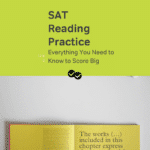The old SAT tested a lot of difficult vocabulary. No more. Now the focus is on “high-utility academic words and phrases” which basically means words that are used in multiple subjects and genres and words that have multiple meanings.
There are two types of Words in Context questions. The first type requires you to correctly identify the definition of a word (remember these are typically common words with multiple meanings). The second type will ask you to identify how an author uses a word or phrase to influence the meaning, tone, or style of a passage.
How the New SAT Tests Vocabulary
Here’s an example of what a word in context question looks like:
As used in line 22, the word “contained” most nearly means to
-
A. sheltered
B. suppressed
C. enclosed
D. incorporated
Contain is not a hard vocab word. So it’s not about knowing what “contain” means; it’s about what it means “in context.” In different contexts, “contain” can mean different things. So we need to figure out what it means in this passage.
Strategy for SAT Reading Words in Context Questions
Your strategy should be to go back to the passage and read not only the sentence the word appears in but also the sentence above and below it. Make sure that you understand how that sentence is supposed to connect to the ones around it.
Then put a blank in the sentence where the word appears. Go ahead and cross it out. Come up with your own word or phrase that expresses what the sentence is saying. Don’t worry about finding the perfect word, just get something down that communicates what the sentence is trying to communicate.
Let’s try it.
It may seem as if the Bubonic Plague is a vestige of the Middle Ages. Most high school students have read about it and its mass devastation of European lives in the fourteenth century. But although the plague may occasionally have been contained, it has resurfaced periodically in various locations around the globe from the 6th century to the 21st century. It is hardly a historical relic.
If I replace the word “contained” myself, I might come up with “stopped” or “prevented from spreading.” These match up best with answer choice (B) “suppressed.” We can see how, in other contexts, “contained” might mean the other answer choices: “The school contained/sheltered the students during the tornado.” “The sheep were contained/enclosed within the pen.” “The lesson contained/incorporated six modules on good writing.” But that’s not what it means here.
Try not to just start plugging in the answer choices from the very beginning. This turns on the how-it-sounds part of your brain instead of the analytical part of your brain (you can probably guess which one the SAT rewards). Only plug words in if you are totally confused and can’t come up with your word.
Remember that the SAT often chooses a second (or third or fourth) definition of a word and not the one that you are most familiar with. So always go back to the passage.
Another Type of SAT Reading Words in Context Question
Although they are far less common, a word in context question may also ask you to determine why an author chose to use a certain word to achieve a certain effect.
Here’s an example:
In line 34, the author most likely used the word “heralded” to:
-
A. echo the idea that the press release acted like a live messenger.
B. emphasize the global acclaim the discovery received.
C. imply that the announcement was fortuitous.
D. highlight the fanfare the press release received.
These questions are tougher because you can’t use the fill-in-the-blank technique. Rather these questions rely on an understanding of main idea and tone and are really more like analysis questions. They are far more rare than the other type of words-in-context questions, however, but be alert for them. The best way to handle these questions is to remind yourself of the main idea of the passage or section.






Leave a Reply